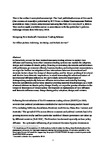Designing New Zealand’s Emissions Trading Scheme
| dc.contributor.author | Inderberg, THJ | |
| dc.contributor.author | Bailey, Ian | |
| dc.contributor.author | Harmer, Nichola | |
| dc.date.accessioned | 2017-10-16T13:28:53Z | |
| dc.date.issued | 2017-08 | |
| dc.identifier.issn | 1526-3800 | |
| dc.identifier.issn | 1536-0091 | |
| dc.identifier.uri | http://hdl.handle.net/10026.1/10060 | |
| dc.description.abstract |
<jats:p> We use the New Zealand emissions trading scheme to explore how diffusion and learning from other emissions trading systems can explain the adoption, design, and revision of climate policy. Drawing on secondary documents and interviews with politicians, government officials, business leaders, and independent commentators, we argue for further investigation of how interactions between international and domestic factors shape the design of climate policy, and for deeper probing of structural and shorter-term domestic imperatives, to avoid misreading the extent and nature of international diffusion influences. We particularly stress the importance of distinguishing analytically between diffusion interactions motivated by learning between jurisdictions and scrutiny aimed at avoiding material disadvantages as a result of miscalculations in climate policy design. Finally, we argue for greater attention to the temporal dimensions of climate policy development in explanations of how diffusion and domestic influences may change during policy adoption, design, and revision. </jats:p> | |
| dc.format.extent | 31-50 | |
| dc.language | en | |
| dc.language.iso | en | |
| dc.publisher | Massachusetts Institute of Technology Press (MIT Press) | |
| dc.subject | 13 Climate Action | |
| dc.title | Designing New Zealand’s Emissions Trading Scheme | |
| dc.type | journal-article | |
| dc.type | Journal Article | |
| plymouth.author-url | https://www.webofscience.com/api/gateway?GWVersion=2&SrcApp=PARTNER_APP&SrcAuth=LinksAMR&KeyUT=WOS:000406705000003&DestLinkType=FullRecord&DestApp=ALL_WOS&UsrCustomerID=11bb513d99f797142bcfeffcc58ea008 | |
| plymouth.issue | 3 | |
| plymouth.volume | 17 | |
| plymouth.publication-status | Published | |
| plymouth.journal | Global Environmental Politics | |
| dc.identifier.doi | 10.1162/GLEP_a_00414 | |
| plymouth.organisational-group | /Plymouth | |
| plymouth.organisational-group | /Plymouth/Faculty of Science and Engineering | |
| plymouth.organisational-group | /Plymouth/Faculty of Science and Engineering/School of Geography, Earth and Environmental Sciences | |
| plymouth.organisational-group | /Plymouth/REF 2021 Researchers by UoA | |
| plymouth.organisational-group | /Plymouth/REF 2021 Researchers by UoA/UoA14 Geography and Environmental Studies | |
| plymouth.organisational-group | /Plymouth/Research Groups | |
| plymouth.organisational-group | /Plymouth/Research Groups/Centre for Research in Environment and Society (CeRES) | |
| plymouth.organisational-group | /Plymouth/Research Groups/Centre for Research in Environment and Society (CeRES)/CeRES (Reporting) | |
| plymouth.organisational-group | /Plymouth/Users by role | |
| plymouth.organisational-group | /Plymouth/Users by role/Academics | |
| dcterms.dateAccepted | 2017-03-17 | |
| dc.identifier.eissn | 1536-0091 | |
| dc.rights.embargoperiod | Not known | |
| rioxxterms.versionofrecord | 10.1162/GLEP_a_00414 | |
| rioxxterms.licenseref.uri | http://www.rioxx.net/licenses/all-rights-reserved | |
| rioxxterms.licenseref.startdate | 2017-08 | |
| rioxxterms.type | Journal Article/Review |


